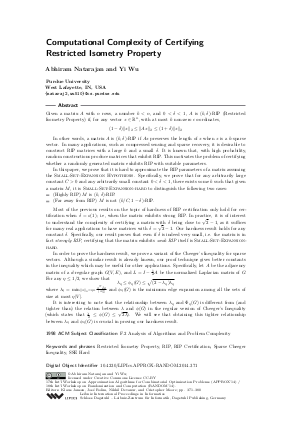Computational Complexity of Certifying Restricted Isometry Property
Authors Abhiram Natarajan, Yi Wu
-
Part of:
Volume:
Approximation, Randomization, and Combinatorial Optimization. Algorithms and Techniques (APPROX/RANDOM 2014)
Part of: Series: Leibniz International Proceedings in Informatics (LIPIcs)
Part of: Conference: International Conference on Randomization and Computation (RANDOM)
Part of: Conference: International Conference on Approximation Algorithms for Combinatorial Optimization Problems (APPROX) - License:
 Creative Commons Attribution 3.0 Unported license
Creative Commons Attribution 3.0 Unported license
- Publication Date: 2014-09-04
File

PDF
LIPIcs.APPROX-RANDOM.2014.371.pdf
- Filesize: 429 kB
- 10 pages
Document Identifiers
Subject Classification
Keywords
- Restricted Isometry Property
- RIP
- RIP Certification
- Sparse Cheeger Inequality
- SSE Hard
Metrics
- Access Statistics
-
Total Accesses (updated on a weekly basis)
0PDF Downloads0Metadata Views
Abstract
Given a matrix A with n rows, a number k < n, and 0 < delta < 1, A is (k,delta)-RIP (Restricted Isometry Property) if, for any vector x in R^n, with at most k non-zero co-ordinates, (1-delta)|x|^2 <= |Ax|^2 <= (1+delta)|Ax|^2. In many applications, such as compressed sensing and sparse recovery, it is desirable to construct RIP matrices with a large k and a small delta;. Given the efficacy of random constructions in generating useful RIP matrices, the problem of certifying the RIP parameters of a matrix has become important. In this paper, we prove that it is hard to approximate the RIP parameters of a matrix assuming the Small-Set-Expansion-Hypothesis. Specifically, we prove that for any arbitrarily large constant C>0 and any arbitrarily small constant 0<delta<1, there exists some k such that given a matrix M, it is SSE-Hard to distinguish the following two cases: i) (Highly RIP) M is (k,delta)-RIP; ii) (Far away from RIP) M is not (k/C,1-delta)-RIP. Most of the previous results on the topic of hardness of RIP certification only hold for certification when delta=o(1). In practice, it is of interest to understand the complexity of certifying a matrix with delta being close to sqrt(2) - 1, as it suffices for many real applications to have matrices with delta=sqrt(2)-1. Our hardness result holds for any constant delta. Specifically, our result proves that even if delta is indeed very small, i.e. the matrix is in fact strongly RIP, certifying that the matrix exhibits weak RIP itself is SSE-Hard. In order to prove the hardness result, we prove a variant of the Cheeger's Inequality for sparse vectors.
Cite As Get BibTex
Abhiram Natarajan and Yi Wu. Computational Complexity of Certifying Restricted Isometry Property. In Approximation, Randomization, and Combinatorial Optimization. Algorithms and Techniques (APPROX/RANDOM 2014). Leibniz International Proceedings in Informatics (LIPIcs), Volume 28, pp. 371-380, Schloss Dagstuhl – Leibniz-Zentrum für Informatik (2014)
https://doi.org/10.4230/LIPIcs.APPROX-RANDOM.2014.371
BibTex
@InProceedings{natarajan_et_al:LIPIcs.APPROX-RANDOM.2014.371,
author = {Natarajan, Abhiram and Wu, Yi},
title = {{Computational Complexity of Certifying Restricted Isometry Property}},
booktitle = {Approximation, Randomization, and Combinatorial Optimization. Algorithms and Techniques (APPROX/RANDOM 2014)},
pages = {371--380},
series = {Leibniz International Proceedings in Informatics (LIPIcs)},
ISBN = {978-3-939897-74-3},
ISSN = {1868-8969},
year = {2014},
volume = {28},
editor = {Jansen, Klaus and Rolim, Jos\'{e} and Devanur, Nikhil R. and Moore, Cristopher},
publisher = {Schloss Dagstuhl -- Leibniz-Zentrum f{\"u}r Informatik},
address = {Dagstuhl, Germany},
URL = {https://drops.dagstuhl.de/entities/document/10.4230/LIPIcs.APPROX-RANDOM.2014.371},
URN = {urn:nbn:de:0030-drops-47092},
doi = {10.4230/LIPIcs.APPROX-RANDOM.2014.371},
annote = {Keywords: Restricted Isometry Property, RIP, RIP Certification, Sparse Cheeger Inequality, SSE Hard}
}
Author Details
References
-
Noga Alon. Eigenvalues and expanders. Combinatorica, 6(2):83-96, 1986.

-
Afonso S. Bandeira, Edgar Dobriban, Dustin G. Mixon, and William F. Sawin. Certifying the restricted isometry property is hard. IEEE Transactions on Information Theory, 59(6):3448-3450, 2013.

-
Richard Baraniuk, Mark Davenport, Ronald DeVore, and Michael Wakin. A simple proof of the restricted isometry property for random matrices. Constructive Approximation, 28(3):253-263, 2008.

-
Jean Bourgain, Stephen J Dilworth, Kevin Ford, Sergei V Konyagin, and Denka Kutzarova. Breaking the k² barrier for explicit rip matrices. In Proceedings of the 43rd annual ACM symposium on Theory of computing, pages 637-644. ACM, 2011.

-
Emmanuel J Candes. The restricted isometry property and its implications for compressed sensing. Comptes Rendus Mathematique, 346(9):589-592, 2008.

-
Emmanuel J Candes, Justin K Romberg, and Terence Tao. Stable signal recovery from incomplete and inaccurate measurements. Communications on pure and applied mathematics, 59(8):1207-1223, 2006.

-
Emmanuel J Candes and Terence Tao. Decoding by linear programming. Information Theory, IEEE Transactions on, 51(12):4203-4215, 2005.

-
Mark A Davenport, Marco F Duarte, Yonina C Eldar, and Gitta Kutyniok. Introduction to compressed sensing. In Compressed Sensing: Theory and Applications. Cambridge University Press, 2012.

-
Ronald A DeVore. Deterministic constructions of compressed sensing matrices. Journal of Complexity, 23(4):918-925, 2007.

-
Subhash Khot, Guy Kindler, Elchanan Mossel, and Ryan O'Donnell. Optimal inapproximability results for max-cut and other 2-variable csps? SIAM Journal on Computing, 37(1):319-357, 2007.

-
Pascal Koiran and Anastasios Zouzias. On the certification of the restricted isometry property. CoRR, abs/1103.4984, 2011.

-
Pascal Koiran and Anastasios Zouzias. Hidden cliques and the certification of the restricted isometry property. CoRR, abs/1211.0665, 2012.

-
George Pólya and Gabor Szego. Isoperimetric inequalities in mathematical physics. Princeton University Press, 1951.

-
Prasad Raghavendra and David Steurer. Graph expansion and the unique games conjecture. In Proceedings of the 42nd ACM symposium on Theory of computing, pages 755-764. ACM, 2010.

-
Prasad Raghavendra, David Steurer, and Madhur Tulsiani. Reductions between expansion problems. In Computational Complexity (CCC), 2012 IEEE 27th Annual Conference on, pages 64-73. IEEE, 2012.

-
Alistair Sinclair and Mark Jerrum. Approximate counting, uniform generation and rapidly mixing markov chains. Information and Computation, 82(1):93-133, 1989.

-
David Steurer. Subexponential algorithms for d-to-1 two-prover games and for certifying almost perfect expansion. Available at the author’s website, 1:2-1, 2010.

-
Terence Tao. Open question: deterministic uup matrices, July 2007.

-
Andreas M. Tillmann and Marc E. Pfetsch. The computational complexity of the restricted isometry property, the nullspace property, and related concepts in compressed sensing. IEEE Transactions on Information Theory, 60(2):1248-1259, 2014.

-
Luca Trevisan. Cs359g lecture 4: Spectral partitioning. CS359G Lecture 4: Spectral Partitioning.

-
Roman Vershynin. Introduction to the non-asymptotic analysis of random matrices. arXiv preprint arXiv:1011.3027, 2010.

